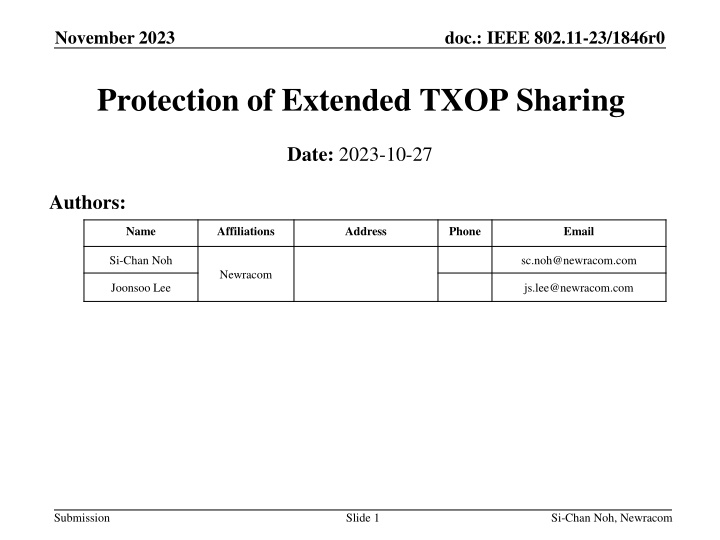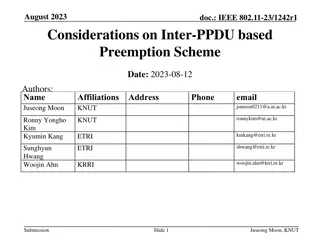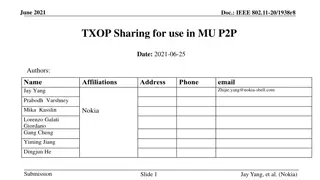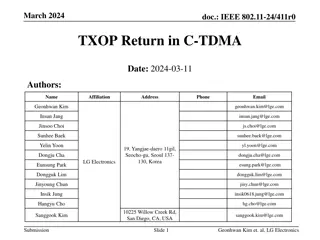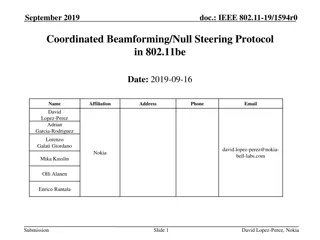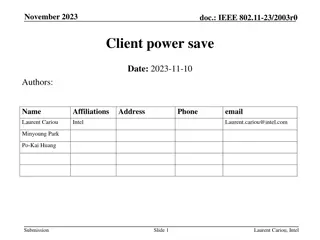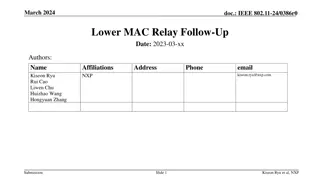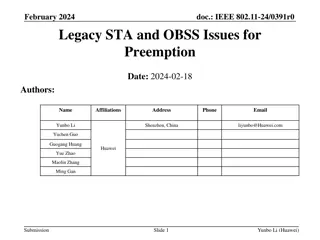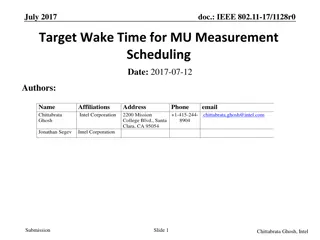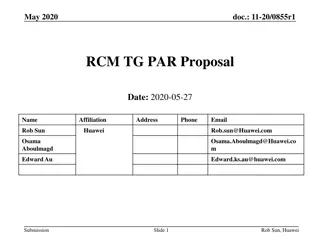Protection of Extended TXOP Sharing in IEEE 802.11-23/1846r0
Reusing EHT's Triggered TXOP Sharing framework for extended TXOP sharing is discussed in this document, focusing on enabling sharing APs to distribute their obtained TXOP among other BSS(s). The document explores issues related to TXOP sharing for UHR STAs when a sharing AP allocates a portion of its TXOP to another AP. Additionally, a mechanism is proposed to enhance medium efficiency by allowing UHR STAs relevant to the sharing AP to utilize the channel within the allocated time.
Download Presentation

Please find below an Image/Link to download the presentation.
The content on the website is provided AS IS for your information and personal use only. It may not be sold, licensed, or shared on other websites without obtaining consent from the author.If you encounter any issues during the download, it is possible that the publisher has removed the file from their server.
You are allowed to download the files provided on this website for personal or commercial use, subject to the condition that they are used lawfully. All files are the property of their respective owners.
The content on the website is provided AS IS for your information and personal use only. It may not be sold, licensed, or shared on other websites without obtaining consent from the author.
E N D
Presentation Transcript
November 2023 doc.: IEEE 802.11-23/1846r0 Protection of Extended TXOP Sharing Date: 2023-10-27 Authors: Name Affiliations Address Phone Email Si-Chan Noh sc.noh@newracom.com Newracom Joonsoo Lee js.lee@newracom.com Submission Slide 1 Si-Chan Noh, Newracom
November 2023 doc.: IEEE 802.11-23/1846r0 Motivation Reusing EHT s Triggered TXOP Sharing(TXS) framework for extended TXOP sharing is under discussion in [2-5] UHR can define a new method of TXOP sharing allows a sharing AP to share its obtained TXOP among other single/multiple BSS(s) The domain of TXOP sharing issues can be modified/extended when enabling the TXOP sharing between multiple APs (M-APs) This contribution discusses TXOP sharing issues for UHR STAs when a sharing AP allocates a portion of its obtained TXOP to another AP. Furthermore, a mechanism that enables UHR STAs, which are relevant only to the sharing AP, to utilize the channel within the allocated time, thereby increasing medium efficiency Submission Slide 2 Si-Chan Noh, Newracom
November 2023 doc.: IEEE 802.11-23/1846r0 Recap : TXS Procedure [1] An EHT AP may allocate time within an obtained TXOP to an associated non-AP EHT STA by transmitting MU-RTS TXS Trigger frame Non-AP EHT STA behavior After a non-AP EHT STA receives an MU-RTS TXS Trigger frame from its associated AP that contains a User Info field that is addressed to it, the STA may transmit one or more non-TB PPDUs within the time allocated in the MU-RTS TXS Trigger frame The time allocation shall start when the PHY-RXEND.indication primitive of the PPDU that contains the MU-RTS TXS Trigger frame has occurred. Submission Slide 3 Si-Chan Noh, Newracom
November 2023 doc.: IEEE 802.11-23/1846r0 Recap : NAV Rule in TXS [1] After sending the CTS solicited by an MU-RTS TXS Trigger frame from the associated AP, the STA that sends the responding CTS shall ignore the NAV that is set by the AP within the time allocation signaled in the MU-RTS TXS Trigger frame When an EHT STA is not received PHY-RXSTART.indication from the PHY during a NAVTimeout, the EHT STA is not permitted to reset its NAV An EHT STA that uses information from a received MU-RTS TXS Trigger frame as the most recent basis to update its NAV should not reset its NAV after the NAVTimeout has expired unless the STA receives a CF-End frame that satisfies the conditions in 26.2.5 (Truncation of TXOP) and 10.23.2.10(Truncation of TXOP) Thus, when an EHT STA which is not participating in TXS procedure does not overhear CTS frame during a NAVTimeout, it does not reset its NAV Submission Slide 4 Si-Chan Noh, Newracom
November 2023 doc.: IEEE 802.11-23/1846r0 Protection in 11be In 802.11be, an AP can share a portion of an obtained TXOP within its BSS (i.e., one associated non-AP EHT STA) Such TXOP sharing within the BSS, protection of other STAs is inevitable to allow recipient STA of the MU-RTS TXS Trigger frame (TF) to transmit one or more non-TB PPDUs within allocated time Follow the rules (i.e., MU-RTS Trigger/CTS frame exchange for EHT STAs) Preceded by an optional CTS-to-self before transmit MU-RTS TXS TF Not reset its NAV after the NAVTimeout has expired when the EHT STAs only overhear MU-RTS TXS TF Submission Slide 5 Si-Chan Noh, Newracom
November 2023 doc.: IEEE 802.11-23/1846r0 Protection in UHR In UHR, extended TXOP sharing is under discussion (e.g., allowing a TXOP acquired by a sharing AP to be shared with single/multiple BSS(s)) When TXOP sharing between M-APs, protection of other STAs is needed to allow the shared AP to transmit or soliciting PPDUs in its BSS within the allocated time However, in some scenarios where there is a UHR STA only relevant to the sharing AP that does not affect the shared AP s BSS, it is beneficial to allow UHR STA to contend for channel within allocated time It means that the domain of TXOP sharing issues can be modified due to the TXOP sharing is extended from single BSS to M-APs Submission Slide 6 Si-Chan Noh, Newracom
November 2023 doc.: IEEE 802.11-23/1846r0 Modified TXOP sharing Issue The sharing/shared AP can exchange frames for TXOP sharing The STAs only can overhear MU-RTS TXS TF (e.g., STA1-2 and AP3) does not reset its NAV according to current NAV rule in previous slide 4 The STA1-2 should not reset its NAV due to the AP1 cannot transmit any PPDUs within allocated time However, the AP3 may not cause collisions with the AP2 s BSS within allocated time, and does not reset its NAV until the end of the allocated time, it can lead to resource wastage For this reason, it is beneficial to have a scheme that allows the AP3 to utilize the channel within allocated time to increase medium efficiency Submission Slide 7 Si-Chan Noh, Newracom
November 2023 doc.: IEEE 802.11-23/1846r0 Proposed Solution The MU-RTS TXS TF can be designed to address TXOP sharing signaling to a shared AP and it should be differentiated with 11be TXS procedure The UHR device can distinguish the MU-RTS TXS TF for the purpose of TXOP sharing in 11be or TXOP sharing between M-APs in UHR Moreover, it can identify whether it is associated with the sharing AP or not If it is not associated with the sharing AP, it can identify the MU-RTS TXS TF is soliciting frame for its BSS or other BSS through the User Info of the MU-RTS TXS TF Submission Slide 8 Si-Chan Noh, Newracom
November 2023 doc.: IEEE 802.11-23/1846r0 Proposed Solution (Cont d) Candidate solution Option 1 : Reset its NAV after the NAVTimout has expired when the UHR device is not associated with the sharing AP and only overhears MU-RTS TXS TF which is not for its BSS Pros : simply modify current rule Cons : only can support UHR devices Submission Slide 9 Si-Chan Noh, Newracom
November 2023 doc.: IEEE 802.11-23/1846r0 Proposed Solution (Cont d) Candidate solution Option 2 : Set the duration field of MU-RTS TXS TF that doesn t cover all the shared AP s BSS frame exchanges Pros : simply modify current rule Cons : cannot overall protection within allocated time Submission Slide 10 Si-Chan Noh, Newracom
November 2023 doc.: IEEE 802.11-23/1846r0 Summary The domain of TXOP sharing issues can be extended when enable the TXOP sharing between M-APs If a UHR STA does not affect a shared AP s BSS within allocated time in TXOP sharing manner, allow the UHR STA to contend for channel within allocated time can increase medium efficiency Submission Slide 11 Si-Chan Noh, Newracom
November 2023 doc.: IEEE 802.11-23/1846r0 Reference [1] Draft P802.11be D4.1 [2] 23/581, Non-AP initiated TXOP sharing [3] 23/261r0, C-TDMA procedure in UHR [4] 23/0249r1, Extended TXOP Sharing [5] 23/0739r1, Follow-up on Coordinated TDMA (C-TDMA) Submission Slide 12 Si-Chan Noh, Newracom
